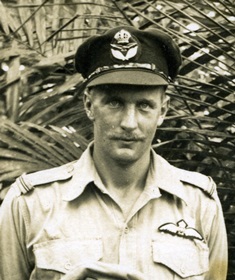PATON, Stephen Macdonald (1921-2000)
Stephen Paton (WW II).
Stephen Paton came to the College as a boarder from 10 February 1937 to December 1939. His address at enrolment was 'Coonara', Tooma, NSW and he had earlier attended Yanco Agricultural High School. At College, he was a member of the 1st Football Teams in 1938 and 1939. He was born on 20 October 1921, the son of Frank McKinnon Paton and Daisy nee Cairnes.
He served with Melbourne University Rifles until, during World War II, he was called up for the Royal Australian Air Force (RAAF) in October 1942. He trained at 11 EFTS (Benalla), 7SFTS (Deniliquin), 2 OTU, School of Army Co-operation, AGS, and served (No. 428391) as a Flying Officer at No 4 (Army Co-operation) Squadron (February August 1944).
The AWM website described No.4 Army Cooperation Squadron:
'From January 1944 'A' and 'B' Flight operated from Gusap and Nadzab airfields respectively, in support of the 7th and 9th Divisions. Here the unit led Beauforts, Vengeances, and Kittyhawks to specific targets identified by the army. When the squadron moved from Port Moresby to Nadzab in March 1944, a detachment was sent to New Britain to support the US Army's westward advance, spotting Japanese escaping to the Gazelle Peninsula. The Gusap detachment returned to Nadzab in July, before moving to Madang in October to cover the 6th Division as it advanced into Bogadjim, Erima, and Angoram. 'B' Flight carried out reconnaissance around the Sepik River, Marienberg, and Anneberg.' Stephen then flew as a Staff Pilot at Air and Gunnery School, and took an HOEFI Course at CFS Camden. He had flown 233 hours on Wirraway, and 252 hours on Boomerang aircraft.
His family hold a cartoon of Steve by an unknown artist. His son, John told the story:
'It depicts him flying a plane, as you would ride a horse with stockwhip in hand! The stockwhip was obviously part of his kit while training in Queensland at least. As I remember him telling the story, he was bored one evening while on training camp somewhere along the Queensland hinterland where they were camped next to an October 1945.' He was discharged from the RAAF on 15 March 1946.
The Australian War Memorial website described No. 114 MFCU :
'The unit embarked from Sydney on 6th June 1943 and disembarked at Milne Bay on 14th June 1943. They moved to Kiriwina on 6th August 1943. They moved again to Los Negros on 16th March 1944. They then returned to Australia arriving at Strathpine on 29th January 1945. They embarked from Brisbane on 3rd April 1945 and disembarked at Morotai on 19th April 1945. The Unit came under the command of the 1st Tactical Air Force (RAAF) and under the direct control of 78 (Fighter) Wing Headquarters. They moved to Tarakan on 1st May 1945. They then returned to Australia arriving at Deniliquin on 18th December 1945. They moved to Schofields on 1st June 1946 and finally moved to Williamtown on 8th August 1946. The Unit was finally disbanded on 1st April 1948.' .jpg)
'Stockwhip' Cartoon of Stephen Paton
(T Paton).
His brother,
Walter Duncan Paton (1925-2017), was also educated at Geelong College.
Sources: Geelong Collegians at the Second World War and Other Conflicts compiled by J. Affleck pp419-420 (citing The Pegasus; Australian War Memorial; National Archives. OGC 1934.